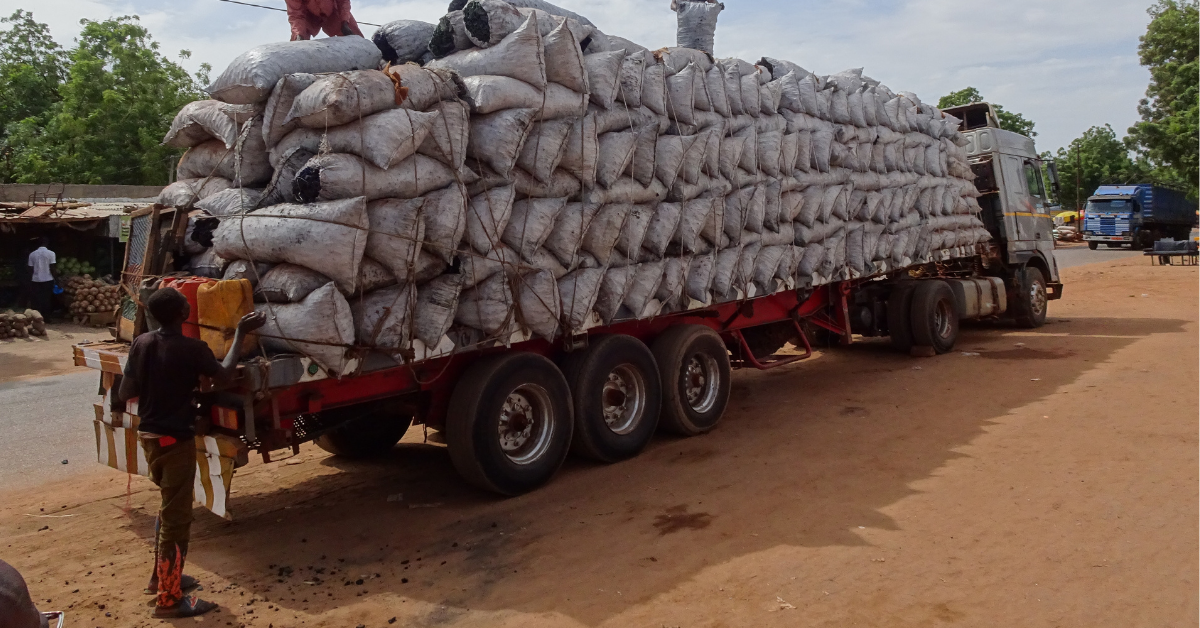Can the Forest Pledge support a sustainable charcoal sector in Africa? It is about understanding the big picture – and the details, write researchers from Sweden, Kenya and Niger.
 Truck transporting charcoal in Niger. Photo: Anders Roos.
Truck transporting charcoal in Niger. Photo: Anders Roos.
The Forest Pledge of November 2nd, signed by over 100 governments at COP26, aims at halting global deforestation before 2030. Similar initiatives to save the forests have been launched before, and we can this time learn from past mistakes. For Africa, the charcoal sector will have a key role to play in the outcome of the Forest Pledge due to its size and role for livelihoods. To succeed this time, the campaign must seriously involve key stakeholders, apply sound management principles and study the linkages between the state of the forests and associated value chains.
Ninety percent of the harvested wood in Africa is used for energy. Charcoal consumption increases more than ordinary fuelwood and is ‘a mega business’ due to population growth and urbanisation. Charcoal is more energy dense compared to fuelwood, which makes it better suited for distribution to ever expanding cities – and to dry regions, such as the Sahel. Charcoal production causes forest degradation, although clearing land for farming is the leading driver behind the ongoing deforestation in Africa. Both men and women participate in different stages of the charcoal value chain, but the most powerful market actors are mostly men.
In a recent project, we studied charcoal value chains in Kenya using operations management models and participatory approaches. Charcoal production and trade generate small profit margins for most value chain actors and it is a labour intensive activity with low ‘entry barriers’. However, producers and other value chain actors need several, often tacit, skills in their work and they adopt elaborated strategies for proper business performance. Charcoal incomes support several Sustainable Development Goals by reducing, if not eradicating, poverty and supporting basic livelihood needs, including paying school fees.
The charcoal enterprises operate in the informal economy and face a harsh business reality with limited alternatives for development. According to the producers, improvements can be achieved through larger charcoal kilns, improved product quality, and fewer accidents or kiln breakages that otherwise cause injuries and economic loss. Better prices can also be gained if producers by-pass intermediaries and sell directly to urban customers. Producers know very well that forests are retreating but they lack the mandate and incentives to implement sustainable forest practices. Local charcoal producing associations claim that communities should be entrusted with the task to regulate wood harvesting and undertake forest regeneration. Formal recognition and support to the charcoal sub-sector would be essential to streamline the operating environment, especially for the actors along the value chain.
Alternative energy sources have serious drawbacks in terms of convenience, costs or reliability. The charcoal ban in Kenya therefore created a ‘vicious policy feedback loop’: Producers lost income, which affected livelihoods.
However, there is a risk that policies follow a different direction. The reaction from policymakers to the increasing charcoal use could be to protect the African forests more vigorously, especially if the Forest Pledge do not consider key needs among charcoal customers and producers. Kenya implemented a ‘Charcoal ban’ in 2018, suppressing most trade and transport of charcoal in the country. However, the solution was not that straightforward. Charcoal is an affordable energy source and millions of low-income urban households rely on it. Alternative energy sources have serious drawbacks in terms of convenience, costs or reliability. The charcoal ban in Kenya therefore created a ‘vicious policy feedback loop’: Producers lost income, which affected livelihoods. Some families even had to take their children out of school when they could not afford to pay the school fees. Consumers, on the other hand, faced increased energy prices also with impacts on household budgets. And despite the ban, charcoal is still traded in Kenya, now by more powerful producers that can handle the new policy. Charcoal import from Uganda and Tanzania has also increased, so called ‘leakage’ when protection efforts in one country lead to more destruction abroad.
So what is the lesson for the coming activities under the Forest Pledge? How is the Pledge viewed by the millions of charcoal producers and consumers in Africa? This is not yet known but research suggests some criteria for more sustainable charcoal value chains in Africa:
- Do not guess but get the facts right about forest uses and their roles for people’s needs. Forest products are increasingly becoming traded commodities. Both forests and associated supply chains form the ‘forest system’ with a key role for poorer households. It is therefore important to map forest value chains and document their contribution to people’s livelihoods.
- Involve (seriously this time) key stakeholders in the discussions about forest governance in Africa. Unheard groups often belong to the most forest dependent, low-income sections of the population. These forest users hold first-hand knowledge about the complexity of forest use and trends, and they understand how forest protection can be combined with basic needs. ‘Experts’ should first tap into these insights before prescribing solutions – simply because it is the only fair, professional and effective way to reach the goals.
Our findings, based on communication with stakeholders, demonstrate the need to protect the forests. However, this must be linked with local empowerment and improvements in living conditions. The greatest underlying threat for the success of the Forest Pledge is not the ongoing forest loss itself – it is rather the underlying poverty and policies based on unfounded assumptions.
Written by:
Anders Roos, Department of Forest Economics, Swedish University of Agricultural Sciences, Uppsala
Chemuku Wekesa, Kenya Forestry Research Institute, Kenya
Doris Mutta, African Forest Forum, Kenya
Mahamane Larwanou, Université Abdou Moumouni de Niamey, Niger
Godwin Kowero, African Forest Forum, Kenya
